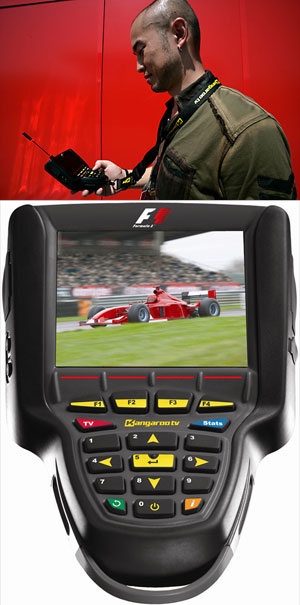Features - Feature
JULY 5, 2006
How to track test a Kangaroo
BY JOE SAWARD

At Indianapolis Kangaroo TV launched an exciting new product which the company said "truly enhances the at-race experience". That may be a long-winded expression but there is no doubt that it is true as the service allows fans to enjoy F1 with an interactive handheld video, audio and data device that gives the user a much better understanding of what is going on.
At Indianapolis Kangaroo TV launched an exciting new product which the company said truly enhances the at-race experience
. That may be a long-winded expression but there is no doubt that it is true as the service allows fans to enjoy F1 with an interactive handheld video, audio and data device that gives the user a much better understanding of what is going on. The service can provide up to 10 live video feeds including live footage, in-car coverage and replays plus 64 audio feeds, including commentary, expert opinions and driver-to-pit radios. One will be able to choose which drivers to listen in on and one has access to some of the same real time data that the teams and the media use as the cars race around the track. In addition there are a wide range of other features including driver profiles that will be included in the package as the service develops. The handheld devices will be available for rent at each Grand Prix although it is yet to be decided how much this will cost at the European events. In the United States Kangaroo TV in NASCAR is available for a rental fee of $50 a day or $70 for the weekend.
Kangaroo Media recently signed a six-year deal with the Formula One group to provide fans with the new service and we were lucky enough to be able to try out the system at Indianapolis Motor Speedway last weekend. There is no question that the Kangaroo device provided a whole new dimension for an F1 journalist. Usually we are stuck in the press offices around the world keeping tabs on the timing screens and the TV pictures but with Kangaroo one can be out and about on the race track and still keep up to date with the action. The screen is of very good quality and so one can see what is going on unless there is direct sunlight bouncing off the screen. The signal quality was very good at Indianapolis although there was only one transmitter in the centre of the track. This meant that there were some areas where the signal was not very strong, particularly if one was in the "shadow" of anything made of concrete. This is easily solved with additional transmitters but much depends on the individual track as not all will need that. The Kangaroo device comes with its own recharger and in our tests we found that the battery life was around seven hours. The company claims six hours of continuous useage. That is just about enough for most race fans but one has to be a bit careful not to start using it too early in the morning if one wants to avoid running out of power in the middle of the Grand Prix - as happened to us during the test. Having said that, there is no question that when one understands the device properly it has the potential to provide a big leap forward for the F1 fan.
The key to success will ultimately be the pricing. In America ticket prices are much lower than in Europe. At Indianapolis one could buy a three-day ticket with access to free grandstands for as little as $60 but in Europe the prices are many times that figure and renting a Kangaroo device for $70 may seen a little excessive. Having said that, there is no question that the device enhances the F1 experience, particularly between the different races when there is little to be seen on the track. The possibilities for content are endless and will be developed as the programme moves along.
In NASCAR, where many fans go from one race to another in the course of the season, there is the possibility of buying a Kangaroo device for around $400 and that may also become possible for F1 professionals and serious F1 fans in the future. We were told that the devices are beer-proof but we decided not to test that out on this occasion, nor did we try dropping the Kangaroo device although best way to avoid that is to keep the device attached to a lanyard and hung around one's neck. For a fairly solid F1 journalist this did not present too much of a load although slim young ladies may find it rather a cumbersome fashion accessory, although there is no doubt that having a Kangaroo around your neck will make you popular with people around you in the grandstands.
All things considered we recommend the Kangaroo TV service highly and look forward to seeing it develop in the years ahead.
For further information see: www.kangaroo.tv.